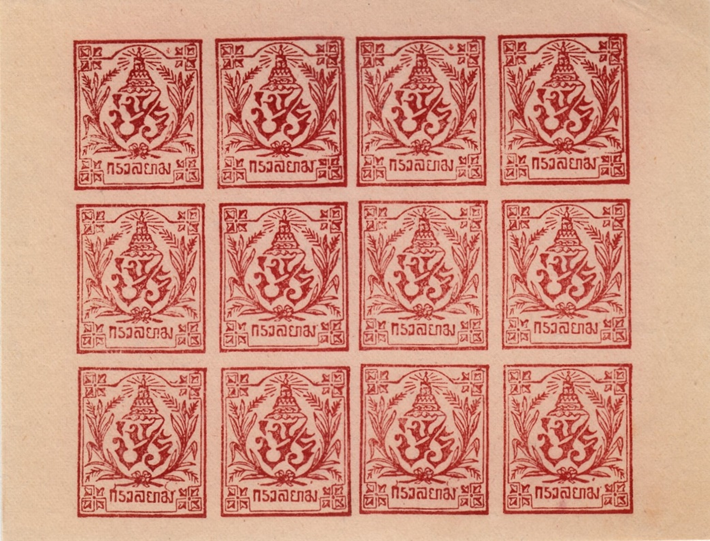The 1875 King’s Monogram Essays of Thailand, part 1
- thailandrevenues
- Aug 5, 2023
- 3 min read
Updated: Aug 21, 2023
By Jos Sanders, May 2023
Some of the most intriguing stamps issued early in the King Rama V reign (1868-1910) are the so-called King’s Monogram Essays. Most philatelic authors, believe the essays were intended for the Agriculture stamps issued later. (Ref. 1 and Ref. 2), perhaps they are not essay at all. They could be seals used on Royal Mail and served as so called Palace Locals.
Issued in 7 different distinct colors and printed with lithographic stones in sheetlets of 12, issued imperforate with or without gum. The paper used is a thick, creamy woven paper. In Yaowanee’s gold exhibit collection is a blue sheetlet of 12 stamps with writing in the margin; seven different stamps, 15 sheets, with a total of105. So, it seems that a total of 180 stamps without gum of each color were printed.

The stamp shows the King Rama V monogram with the royal crown above. It is surrounded by two rice stalks tied in the middle by a ribbon. The Thai letters on the bottom reads “Siamese State” although one of the letters is misspelled.

The left picture shows the monogram of King Chulalongkorn (Rama V) of Siam, reading "จปร", standing for "จุฬาลงกรณ์ ปรมราชาธิราช, equivalent to "CR" in English, for "Chulalongkorn Rex".
The middle picture shows the essay with the error in the letter indicated by a black arrow, the right picture shows a part of an actual Agriculture stamp issued later where the error in the lettering is corrected.
The design frame is 21.9 X 25.4 mm although there is some variation possibly due to some paper shrinkage. Studying the 12 stamps in a sheetlet, it becomes clear that the sheetlet is printed with a six-image stone 2x3 and each sheets has two impressions. Each of the 6 stamps in 1 impression have some unique flaws making it possible to plate individual stamps. (Ref. 2).

Colors
Currently, seven colors are identified in the stamps both without and with gum. The colors are quite similar with the colors in the actual issued Agriculture stamps with perforation 13.5. Red Violet, Blue Violet (previous name Plum), Blue, Red, Green, Orange and Purple (Ref. 3).
Stamps with gum or partial gum are always found on single stamps. Many of those stamps have either heavy paper hinges or were even stuck in albums in Victorian style i.e. glued with their gum on a page. Many of these stamps have thins or tears where they were pulled out of the albums. For stamps without gum, all sheetlets seen by me were issued without gum. Loose stamps without gum can either be cut outs of stamps from the sheetlets, or it were before gum stamps which somehow lost their gum. Stamps issued without gum seem to have different shades than those issued with gum. In general, stamps with or without gum have the same flaws, similar wove paper and seem to printed from the same stones.

I consider the stamps with gum as printed before the stamps without the gum. It is still a mystery to me why the sheets without gum had to be printed while there seemed to be a lot of mint gummed stamps around.
Peter Collins in reference 1, mentioned that he has seen sheets of 12 stamps with thin paper and with gum. He mentions the colors red, blue, green and red brown. I have never seen any sheetlet or even individual stamps with this, non-wove paper.
According most authors, the above stamps were the so-called essays for the first series of the agriculture stamps with perforation 13.5. Yes, both have the same design features and I feel confident that both are printed in the same printing house in Paris, France. However, the late Charles Steward suggested that above illustrated stamps were seals applied to royal mails (Ref. 2). In 2003, I purchased on eBay a revenue lot from a dealer in Argentina. The lot contained several so-called Essay stamps of which 1 was cancelled.

With this stamp, the suggestion from Steward becomes a little bit clearer, although there is, of course, no guarantee that the stamp was actually used. If indeed used on palace royal mail as a seal it falls in the group of so-called Palace locals. Yes, the monogram design was later used as part of the agriculture stamps but they were not specifically designed as essays.
References
Ref. 1, Peter Iber, The King’s Monogram Essays, Thai Philately, January 1984, page 6-7
Ref. 2, Peter Collins, Royal Monogram and Crown Essay, The Thai times, 1979, page 9.
Ref. 3, Jos Sanders, Thailand Agriculture Revenues First issue 1882-1896. To be published in the Thai Times
You can find the full list of references here.



link link link link link link link link link link link link link link link link link link link link link link link link link link link link link link link link link link link link link link link link link link link link link link link link link link link link link link link link link link link link link link link link link link link link link link link link link link link link link link link link link link link link link link link link link link link link link link link link link link link link link link link link link link link link link link link link